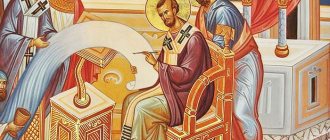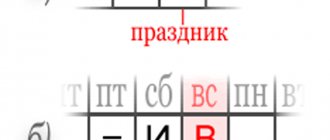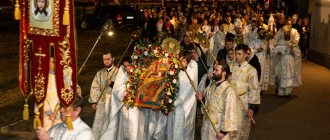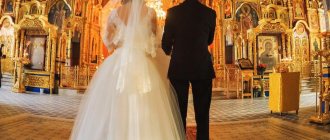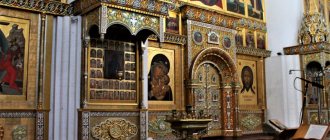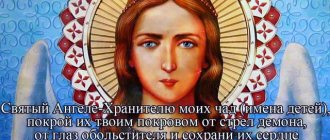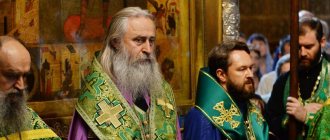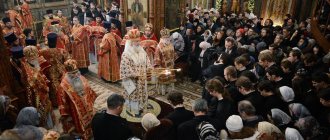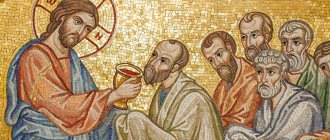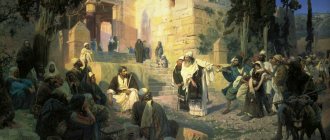Christianity, like any other established and mature religion, has a large number of rituals. They allow the congregation to feel like they are part of something important and strive for it with all their thoughts and actions. Services and rituals in Orthodoxy and Catholicism have much in common, but there are also many differences between them. Usually, they do not immediately become noticeable to newcomers who have just come to God, since becoming a church member is a long process, during which the meaning of all the sacraments and rituals is gradually revealed. However, even those parishioners who consider attending divine services an unchanging part of their lives cannot always explain their meaning, talk about the significance and list the rites. The Liturgy of the Catechumens is a church service that seems to be one of the most difficult for the Orthodox to understand. Many cannot even say when it begins and how it ends. But in fact, the liturgy of the catechumens is an important part of the collective service of God in Christianity and has its own history of formation, turning us back to the times when the followers of the religion were subjected to mass persecution. Today we will talk in detail about this liturgy and separately highlight all its stages.
Liturgy: let's look at the terminology
In order to begin to tell readers directly about the liturgy of the catechumens, it is important to have some understanding of Orthodox terminology. First of all, let's look at what exactly this service is.
The word "liturgy" came to us from the Greek language. Translated, it means “common cause,” which perfectly characterizes the essence of this action. From the time when Christianity was in its infancy, worship services were collective. Initially, this was the only opportunity to praise the Creator and gain knowledge about Christianity.
Today, many people also participate in the liturgy. They can be roughly divided into four categories:
- the clergyman leading the service;
- deacons;
- choristers;
- parishioners.
The actions of all participants in the worship service are usually quite coordinated and subject to certain rules. At the same time, many parishioners consider themselves merely listeners of prayer, which is a fundamentally incorrect attitude towards the liturgy. After all, ordinary people who come to the temple cannot be passive spectators of everything that happens at the altar. They take a direct part in everything. And this is especially true for prayer. Indeed, in Christianity, collective prayer is endowed with special power. At such services, you need to turn to God not only with your problems and concerns, but also to delve into the words of the priest in order to turn your heart to the Creator in a single impulse. At such moments, true blessing descends on all those praying.
Previously, it was believed that without such prayers it was impossible to perform the sacrament of communion, since the bread and wine would not turn into the blood and body of Christ. However, to this day in many churches the same attitude towards the liturgy of the catechumens remains. In part, it can be considered true, but still this service also has a different meaning. First of all, it must be perceived as an important part of the Great Liturgy, which can be both everyday and festive.
Small entrance
During the singing of the third antiphon, the small entrance with the Gospel begins.
The priest also reads the following prayer.
Sovereign Lord our God, who has established in heaven the ranks and hosts of Angels and Archangels for the service of Your glory! Create at our entrance the holy Angels of existence, who will serve us and praise Your goodness.
For due to You is all glory, honor and worship, to the Father and the Son and the Holy Spirit, now and forever and to the ages of ages. Amen.
The parishioners hear only the last part of it, spoken loudly.
Established - “established.”
Create with our entrance the entrance of holy Angels - “make it so that together with our entrance there will be an entrance of holy Angels.”
The deacon proclaims:
Wisdom, forgive me! - “Wisdom! Stand up straight!” The Church Slavonic word wisdom also means “teaching.” These words are pronounced before important moments of the service, at the Liturgy of the Catechumens - before the singing of the Trisagion, the reading of the Apostle and the Gospel.
The choir sings:
Come, let us worship and fall before Christ. Save us, Son of God, risen from the dead, (on weekdays - in holy wonders) singing Ti: Alleluia.
We - "us".
Sy - “there is.”
Following are the troparia and kontakions of the holiday, as well as the patron saint of the church where the liturgy is celebrated. At this time, the priest reads a prayer to himself:
Holy God, who rests among the saints, who is sung with the thrice-holy voice from the Seraphim and glorified by the Cherubim, and who is worshiped by all Heavenly Powers, who was brought into being from nothingness and all things, having created man in Your image and likeness, and adorned with all Your gifts, Give to the one who asks wisdom and understanding, and do not despise the sinner, but rely on repentance for salvation, enabling us, Your humble and unworthy servants, and at this hour to stand before the glory of Your holy altar , and offer the worship and praise due to You. Yourself, Master, accept from the lips of us sinners the Trisagion hymn, and visit us with Your goodness, forgive us every sin, voluntary and involuntary, sanctify our souls and bodies, and grant us to serve You in holiness all the days of our lives, with the prayers of the saints Mother of God, and all the saints who have pleased You from time immemorial.
Rely on repentance for salvation - “he who has appointed repentance for salvation.”
In veneration - “in holiness.”
Short description
When we talk about divine services in Orthodoxy, then almost one hundred percent we mean the Byzantine rite. It arose almost at the dawn of Christianity and consists of several parts, one of which is the Liturgy of the Catechumens.
The main purpose of the Byzantine rite is considered to be the preparation of the believer for communion. He must once again remember all the foundations of Christianity, moments from the earthly life of Christ and his suffering during the crucifixion. In a limited time interval, the Church explains to parishioners why God sent His Son to people and explains the importance of the sacraments. It is in this way that one can briefly describe the essence of the liturgy of the catechumens.
But why is it named like that? This question interests almost everyone who has recently come to God and is just getting acquainted with most rituals. The answer to this is extremely simple. The divine service, which is commonly called “liturgy,” is a single action. But it consists of several parts. The most important and impressive in time are the Liturgy of the Catechumens and the Liturgy of the Faithful. Their names were given in ancient times, and they are associated with the sacrament of communion.
The fact is that a certain category of parishioners does not have the right to take part in this ritual. This group includes people excommunicated from communion, those repenting for committing sins, and those who are just preparing for baptism. They can attend the entire service, except for its final stage. For this period they must go outside the temple. The signal to leave the church is the announcement of the priest, which is why the part of the service accessible to the listed category of people was called the “liturgy of the catechumens.”
The meaning of liturgy
Today this part of the service is underestimated by many Orthodox; they do not understand its importance and perceive it as a stage preceding communion. However, in Ancient Rus', all church sacraments were taken very seriously. An outsider who had not gone through a long preparatory stage simply could not become a Christian. The time interval from a person’s will to accept Orthodoxy to the sacrament itself could stretch for years. This was especially typical for the Old Believers, but even in an ordinary church a person underwent several months of training and only then received the right to become a Christian. The process of becoming acquainted with religion necessarily included attending the main services as an active participant throughout the entire time allotted by the spiritual mentor for training.
The Liturgy of the Catechumens was the only opportunity to attend the service preceding communion. After receiving baptism, the believer received the full right to defend the service in full and not leave the temple after the announcement.
It is interesting that the priests themselves are always happy to tell parishioners about the meaning of the liturgy from the point of view of the church. They say that each stage is symbolic of certain events. For example, the first words of the service are a kind of angelic song, announcing to humanity the birth of the Son of God. The obligatory singing refers to the sermons of Christ, which he preached at different times. The Small Entrance can be correlated with Jesus' journey through Palestine and preaching the true faith in all cities and villages. Further stages of the liturgy should remind people that they need to pray not only for loved ones, but also for those who have not found the grace of eternal life without accepting the Almighty as their only god. This category needs guidance and guidance, which means that prayer can become a kind of guiding star for them.
In Constantinople and other cities in ancient times, liturgies were celebrated very magnificently. They were accompanied by a religious procession with mass sermons. Typically, such services were held as gratitude for deliverance from the epidemic, in honor of the end of the war, or as a petition for protection in difficult times. In ancient times, the Liturgy of the Catechumens did not always take place in the church. Quite often, after the procession to the church doors, people remained behind them and listened to the service from the street. They were considered direct participants in the action, regardless of their location. After the announcement, the doors of the temple were closed, and only those who had the legal right to take part in the sacrament of communion were inside.
Catechumens in the 4th–5th centuries.
By the Edict of Milan in 313, Christianity was recognized as a permitted religion in the Roman Empire. In addition, it received the patronage of St. equal to Emperor Constantine the Great and all his successors with the exception of Julian the Apostate. Already in 380, Emperor Theodosius the Great, by edict Cunctos populus, recognized the Nicene faith, that is, proclaimed by the First Ecumenical Council, as mandatory for all subjects of the Empire.
The announcement thus continued to develop under completely new conditions. The two stages of the catechumen, which were spoken of by the Apostolic Tradition, have been preserved, but have undergone some changes. Due to the fact that becoming a Christian was no longer dangerous, but often provided additional benefits, the number of people wishing to become catechumens increased. Often the opportunity to question those who came in detail was lost. They could be admitted to the category of catechumens without additional testing through making the sign of the cross, laying on of hands and incantation. They could attend divine services, with the exception of the Eucharist itself (“liturgy of the faithful”), read Scripture, listen to sermons, which replaced special classes.
It became commonplace to prolong one's stay in the rank of catechumens. This could be due to the fact that the same moral requirements were not applied to the catechumens as to the faithful, or because of established custom. Thus, we know about the Baptism by adults of the Church Fathers who came from Christian families: the Great Cappadocians, St. John Chrysostom, Blessed. Augustine of Ippona. All of them, however, eventually became preachers of early Epiphany.
Those who wished to receive Baptism as soon as possible reported their names to the bishop for recording and only then proceeded directly to preparation, which ended with the celebration of the sacrament on one of the main holidays: Easter, Pentecost, Epiphany (depending on local custom). Such catechumens were called “enlightened” (“φωτιζομένοι”, “illuminandi”) or “elected” (“electi”).
A description of such a practice is contained in the famous “Pilgrimage” of Egeria, travel notes of a Western pilgrim made on a trip to the East. The pilgrimage took place in the second half of the 4th century. and its record reflects the catechetical practice of Jerusalem. The author reports (Pilgrimage, 45) that the name should have been recorded among those baptized before the beginning of Lent. This was done by the presbyter, and the bishop, at the beginning of Lent, in the presence of the clergy, one by one received everyone on the lists along with their recipients and asked friends about them. If they had a good testimony, they were included in the “elect.” Then, during the forty days of Lent, after the morning service, the catechumens preparing for Baptism were conjured by the presbyters, and after this the bishop began his teaching for them. Only the faithful and catechumens, who intended to receive Baptism at the coming Easter, could listen to him. The bishop gradually expounded the Scriptures “from Genesis” and interpreted them. After five weeks, the catechumens “received” (listened to) the symbol, and the bishop explained it. Each session lasted for three hours, from the first to the third hour. In the last week of Pentecost, the catechumens again came to the bishop one by one, “the husband with his father, the wife with her mother,” that is, with their guardians, and “returned” (i.e., read) the symbol to the bishop, after which he reported that after Baptism, the “hidden mysteries of God” will also be explained to the newly enlightened.
The content of the Jerusalem Catechumen is shown by the “Catechetical Teachings” of St. Cyril of Jerusalem. The catechetical conversations of St. have also been preserved. John Chrysostom and Theodore of Mopsuestia, containing information about the immediate preparation for Baptism in Antioch. Here it lasted thirty days, and the catechumens had greater access to knowledge about the sacraments. The announcement in the West is reported in the works of the blj. Augustine and St. Ambrose of Milan. Here, less attention was paid to the interpretation of the symbol, and there was also no “private” reading of it before the bishop by each of those being baptized.
By the end of the 5th century. The institution of catechumens begins to decline. This is due to the fact that the majority of those baptized are beginning to be infants, children of Christian parents. Despite this, in the Typikon of the Great Church, that is, the liturgical charter of the Church of Hagia Sophia in Constantinople (10th century), the catechumenate is still associated with Great Lent. And although the “catechumens” were mostly children three years old, the main rites of catechumen were still performed on them.
Traces of the catechumen have been preserved in modern worship. Thus, at the Liturgy of the Presanctified Gifts, from the middle of Great Lent, a special litany is pronounced about “those who are preparing for enlightenment.” Prayers for the catechumens are present in the rite of the Divine Liturgy, and finally, the Breviary contains “the prayer to create the catechumen,” exorcisms, the rite of renunciation of Satan and the combination of Christ, as well as the reading of the Creed, which recalls its “return” in the Ancient Church. This rite is usually performed immediately before the sacrament of Baptism.
Stages of the liturgy
In Orthodoxy there is a special science of conducting divine services - liturgics. The Liturgy of the Catechumens, according to its canons, consists of several parts. Each has its own meaning and is subject to strict consistency. We will outline all stages of the service in a simplified and concise version:
- Proskomedia. To be as precise as possible, this is not the liturgy itself, but its threshold. At this stage, a kind of sacrifice of bread and wine is made, which will then be used to give communion to the parishioners.
- Great Litany. Litany is an important part of all church services and is a list of petitions to the Lord.
- Antiphons. This term hides the chants that choristers must recite. In ancient times this was done through two choirs located opposite each other.
- Hymn.
- Small Litany.
- Singing.
- Small entrance.
- An explanation of the Christian faith. This process includes reading the Gospel.
- Four litanies, coming sequentially one after another: the august one, about the dead, about the entry of the catechumens, and about the exit of the catechumens.
For beginners, all of the listed stages may seem incomprehensible, and the service itself may seem too long. It is impossible to answer for sure how long the Liturgy of the Catechumens lasts. Despite the fact that all its parts are subject to strict order and clearly regulated, each clergyman puts his whole soul and faith in God into it. Therefore, serious discrepancies in the time of serving the Almighty are possible.
Prayer before reading the Gospel
An excerpt from the Apostle and the Gospel, set for this day of the year, is read, preceded by a prokeme and alleluia (going along with the repeated singing of “alleluia”) - short verses of a psalm. The choice of a verse from a psalm depends on the day of the week, the holiday, and also the voice in which the chants are sung in turn.
Before reading the Gospel, the priest also silently reads a prayer:
Shine in our hearts, O humane-loving Master, the imperishable light of Your God-mind, and open our mental eyes to understanding in Your Gospel sermons. Place in us the fear of Thy blessed commandments, so that all carnal lusts may be trampled, we will pass through spiritual life, all that is to please Thy, both wisely and actively. For You are the enlightenment of our souls and bodies, O Christ God, and we give glory to You, with Your beginningless Father, and Your most holy and good and life-giving Spirit, now and ever, and to the ages of ages. c. Amen.
Mental - that is, spiritual.
Residence is “life.”
All, even - “everything that.”
Wisely - “thinking.”
Acting - “doing.”
The deacon proclaims:
Bless, master, the evangelist, the holy apostle and evangelist (name of the evangelist) . - “Bless, O Lord, the holy apostle and evangelist (name of the evangelist) who proclaims the gospel.”
Priest:
May God, through the prayers of the holy, glorious, all-validated apostle and evangelist (name), give you the word, who preaches the gospel with great power, to fulfill the Gospel of His beloved Son, our Lord Jesus sa Christa.
Verb - “word, gift of speech.”
For the fulfillment of the Gospel - “for the fulfillment of the Gospel.”
The most common questions regarding the liturgy
Very often parishioners who have just embarked on the path of faith are embarrassed to ask questions about divine services. As a result, they lose interest in these important actions and sometimes miss significant stages that would make them stronger and more spiritual in the future.
Often, interest is aroused by which liturgy is more important - holiday or daily. There can be no two answers on this topic. In Orthodoxy, any appeal to God is an important and significant action. And taking part in common prayer, which the liturgy represents in a sense, gives a person spiritual strength and strengthens him in faith. Therefore, be sure to take the time and take part in this action, which is very important for every Christian. At the same time, one should not divide the liturgies among themselves according to their significance.
When it comes to churchgoers who have recently come into the fold of the church, they tend to make the mistake of dividing one service into parts according to the degree of importance. With this approach, the Liturgy of the Catechumens and the Liturgy of the Faithful are considered different. The first is perceived by baptized people as optional for presence. And the second, after which communion occurs, is considered extremely important. The priests are categorically against this approach to serving God. They argue that the Liturgy of the Catechumens is a preparatory stage for the sacrament, and therefore should not be skipped under any circumstances.
In order to make it easier for readers to understand the main essence of the liturgy and take conscious participation in it, we will give some explanations of its most important stages.
Catechumens in the modern practice of the Russian Orthodox Church
In the 20th century interest in the ancient practice of announcement increased both in the West and in the East. After the fall of Soviet power in Russia, the number of people wishing to receive Baptism increased many times over. Often these people did not even know the basics of faith. At the same time, the opportunity arose to develop religious education. As a result, numerous catechesis courses and training for catechists began to appear. Currently, the position of the catechumens is regulated by the regulation “On religious, educational and catechetical service in the Russian Orthodox Church” adopted in 2011. The first paragraph of the second section is directly devoted to the announcement. The catechumen is defined as “a set of conversations and instructions to those preparing to receive Holy Baptism.” Those who wish to receive holy Baptism over the age of seven can become catechumens. In the case of the Baptism of an infant, public conversations are held for his parents and recipients, which to some extent brings to mind Byzantine practice. In the case of Baptism in mortal danger, the announcement may be made after Baptism. The length of the catechism period is determined by the priest or catechist.
The document also defines the approximate content of the announcement. Conversations (at least two) should introduce the catechumen to the Creed, some passages from Holy Scripture, the foundations of Christian morality and the liturgical life of the Church. The catechumen is required to have faith and repentance, as well as awareness of the meaning of the sacrament of Baptism. The document also expresses hope for the revival of the ancient practice of Baptism on the eve of Christmas, Epiphany and on Holy Saturday for the sake of participation in the sacrament of the entire community into which the newly baptized person enters.
Notes:
Afanasyev N., protopres. Joining the Church. Gavrilyuk P., diac. History of catechesis in the ancient church. Gavrilyuk P., diac. History of catechesis in the ancient church. Scriptures of the Apostolic Men. Preface to the Teachings of the Twelve Apostles. Scriptures of the Apostolic Men. Didaches. Panteleev A.D. Early martyrdoms. Translations, comments, research. Justin Philosopher. Apologies. John (Popov), martyr. Lecture notes on patrolology. Tertullian. About Baptism. Apostolic Tradition // Orthodox Encyclopedia. T. 3. (https://www.pravenc.ru/text/75758.html). Afanasyev N., protopres. Joining the Church. Gavrilyuk P., diac. History of catechesis in the ancient church. Etheria (Sylvia of Aquitaine). Pilgrimage to holy places of the late 4th century. Cyril of Jerusalem, St. Catechetical and secret teachings. Gavrilyuk P., diac. History of catechesis in the ancient church. Announcement // Orthodox Encyclopedia T. 52 P. 382. Ibid. On religious, educational and catechetical service in the Russian Orthodox Church. Right there.
***
“The word κατηχούμενοι, found in Holy Scripture (Rom. 2:18; Gal. 6:6; cf. Acts 18:25; 1 Cor. 14:19), denotes those persons who, in order to be received into the Christian Church, must study Christian doctrine (Matt. 28:19; cf. Acts 18:25: κατηχημένος τήν οδόν τού Κυρίοu). Consequently, these were, so to speak, candidates for baptism. The teaching of Christian doctrine was called κατήχησις or λόγος κατηχητικός (institutio catechetica), as well as κατηχισμός. The teacher of persons preparing for baptism was called κατηχητής or κατηχιστής (catechista). The place where the training took place was called κατηχουμενείον. The catechumens, or katichumen, were usually divided into several categories: two, sometimes three, four, and even five. We adhere to the opinion of the medieval Greek commentators: Zonaras, Balsamon, Aristinus and Matthew Blastarus, who divide them into two categories. In his interpretation of this Nicene rule, Aristinus says: “there are two kinds of catechumens, some who have just entered (οί μέν γάρ άρτι προσέρχονται), and others who have become more perfect (τελεώτεροι), since they are sufficiently trained in the truths of faith.” Zonara and Balsamon say the same in their interpretation of the 5th rule of the Neocaesarea Council, and Aristin repeats the same in his interpretation of this rule. Referring to the interpretations of the mentioned commentators, Matthew Blastarus says the same thing in his Alphabetical Syntagma. Consequently, the catechumens are divided into two categories. When any pagan or Jew declared his desire to join the ranks of the catechumens, he had to turn to some lay Christian or to a deacon, who, vouching for his good intentions, brought him to the appropriate presbyter or bishop (Apostolic resolutions, VIII, 32). The bishop or presbyter, convinced of his good intentions, read him the prescribed prayer, crossed him and introduced him to the first category of catechumens, who were taught the first truths of Christian teaching. They were called άκροώμενοι (audientes), since they were allowed to come to the church for the liturgy and listen to the reading of the Holy Scriptures and the Gospel, after which they immediately had to leave the temple. In the first category, catechumens usually remained for three years (Apostolic Decrees, VIII, 32), although this time could be shortened or extended in accordance with the zeal and behavior of the person in question. In those cases when the katikhite saw that his students were sufficiently familiar with the basic information from Christian teaching and that they were worthy in their good behavior, he allowed them to move to the second category of catechumens, where the latter extensively expounded Christian teaching and especially explained the symbol with all the details faith. They were called έυχόμενοι (orantes), because they could pray with the faithful even after the Gospel, or γονυκλίνοντες (genuflectentes), because they knelt when a prayer was read to them during the liturgy, or also συναιτούντες (com petentes) and τελεώτεροι (perfectiores, electi). They remained in the church until the deacon during the liturgy addressed them with the words: “Depart, ye catechumens,” after which they left the church. The length of their stay in this degree also depended on their zeal for learning and on their behavior. Catechumens of the first and second classes were given a place in the church along with penitents of the second class, i.e. in the vestibule (νάρθηξ, πρόναος) in front of the place designated for baptism (κολυμβήθρα), near the main entrance to the church.” Rules of the Holy Orthodox Church with interpretations of Bishop Nicodemus (Milash). Rules of the Ecumenical Councils of the Holy First Ecumenical Council, Nicaea. Interpretation of Rule 14
Beginning of the liturgy
After the proskomedia, the priest and deacon begin preparing the parishioners for the sacrament of communion. The first words of the liturgy are prayers for the calling of the Holy Spirit. They are pronounced by the priest and deacon in turn. The choir members echo them. The congregation usually repeats only the last words of the text, which represent a kind of seal confirming and securing what was said.
It is believed that during the liturgy the Lord himself directs everything that happens. And the participants in the action are his assistants. Moreover, the status of a person is not important here - priests and ordinary parishioners are equal before God.
Next comes the turn of the great litany. It should be carried out only in a good mood, so the priest begins it with a prayer designed to instill peace in the hearts of the parishioners. In Christianity, it is strictly forbidden to make any sacrifices to the Lord, which includes prayer, while in an angry or irritated state.
The prayer is read in several stages, each including certain petitions. In the process, the priest covers almost all areas of a person’s life, with special emphasis placed on spiritual insight. Mercy is also asked for all those praying and the church itself. In addition to the points already listed, asking for a blessing is considered important. It is during the liturgy that the grace of God descends on all those taking part in it.
The Great Litany
After reading the Gospel, the deacon pronounces a special litany - “a strengthened, or special, petition.”
We say everything with all our hearts, and we say everything with every thought.
Rtsem - “we speak.” This means that everyone who comes to the service must participate in prayer.
Have mercy on us, O God, according to Your great mercy, pray, hear and have mercy.
Velitsey - “great”.
We pray = we pray to Ti, i.e. “we pray to You.”
We also pray for the blessed and ever-memorable creators of this holy temple, and for all the departed fathers and brothers who lie here and are Orthodox everywhere.
Otsekh - “fathers”.
Here - here.
We also pray for those who are fruitful and virtuous in this holy and all-honorable temple, the people who work, sing and stand, expecting great and rich mercy from You.
Fruitful - “bearing fruit (of good deeds).”
Toilers - “toilers”.
At this time, the priest quietly prays the Prayer of Diligent Supplication.
Lord our God, accept this earnest prayer from Your servants, and have mercy on us, according to the multitude of Your mercy, and send Your bounties upon us and upon all Your people, who seek rich mercies from You.
Generosity - “mercy”.
On us - “on us”.
And loudly pronounces her final words:
For You are a merciful and loving God, and we give glory to You, the Father, and the Son, and the Holy Spirit, now and ever, and unto the ages of ages.
Antiphons
Singing is an integral part of serving the Lord. But it has some differences depending on what kind of service is being conducted. During the liturgy, significant attention is paid to antiphons. They are psalms sung as a whole or in groups of several verses. A distinctive feature of antiphons from other chants is the manner of their performance. Both choirs should sing the psalms alternately.
This creates a special atmosphere that fills the temple with the glorification of God. The antiphons consist entirely of glorifying texts, and when singing comes from all sides, a special goodness descends on those praying, filling their hearts and souls with love for the Lord.
It is interesting that initially antiphons were independent chants. They were often performed by parishioners heading to the temple. Then they began to be used during processions of the cross before the start of the liturgy.
And only over time they became a full-fledged part of the worship service. Today it is quite difficult to imagine the liturgy without these praises, alternating with prayer.
Let us immediately note that the choir sings several antiphons. They are combined with the small litany and prayer of the clergyman. When the first antiphon is sung, the church minister reads a prayer for the protection of all Orthodox Christians, and in particular those who belong to the parishioners of this church. At the same time, a small litany is read, the words of which are joined by all those present in a single impulse.
The second antiphon is entirely dedicated to the Son of God. The chants tell how the divine and human principles merged in Jesus Christ, which allowed him to love all people without exception and give his life for them. At the same time, the priest reads a prayer for the granting of eternal life and blessings. Immediately after it, another small litany is said.
The third antiphon is dedicated to the commandments of God. The chants glorify the Lord, who wisely judged by giving people a set of rules according to which they can live righteously. Usually at this stage there is a small entry.
Great Litany
Then the deacon pronounces the great litany (in Greek - “strengthened petition”): Let us pray to the Lord in peace.
The word world also has the meaning of “universe” and more narrowly: “the human race” and “community of believers” (compare with modern laity). There was another word “peace” - the same one that the priest pronounces in the exclamation Peace to all! and which we hear in the subsequent words of the deacon at the great litany: Let us pray to the Lord for peace from above and the salvation of our souls, for the peace of the whole world - with the meaning of “peace, peace of spirit.” For convenience, in distinguishing these homonym words in Church Slavonic grammar, they even introduced a rule: the world as “universe” was written through i (and short), and the world as “peace” - through and ordinary. Thus, the deacon calls to prayer the members of the Christian community gathered in this church, and in the future - all people in the universe.
Let us pray to the Lord for peace from above, the welfare of God’s holy churches and the unity of all.
About the above peace - not just about a peaceful state of spirit, but about the peace sent down from above, about which Christ said: “Peace I leave with you, My peace I give to you” (John 14:27).
The welfare of God's holy churches - "firm (good) standing." Churches used to be called not a stone or wooden building for prayer, but a Christian community. Thus, this is a prayer for the strengthening of Christians in faith.
Let us pray to the Lord for this holy temple and for those who enter it with faith, reverence and fear of God.
In on - “into him.”
For this city, every city, country and those who live in them by faith, let us pray to the Lord.
Grad - "city". In rural churches they say “about this weight,” and in monasteries they say “about this holy monastery.” “Ves” in Church Slavonic means a village, a small settlement.
Let us pray to the Lord for the goodness of the air, for the abundance of earthly fruits and times of peace.
About the goodness of the air - “about good weather.”
Times of peace - “times of peace.”
Let us pray to the Lord that we may be delivered from all sorrow, anger and need.
About getting rid of us - “about getting rid of us.”
Need - “danger, torment, trouble.”
Let us commit ourselves and each other and our whole life to Christ God.
Belly - “life”.
Small entrance: description and meaning
Even while the choir is singing the psalms, the clergyman goes behind the altar. A few minutes later he comes out with the Gospel and goes around everyone present. At the same time, a prayer is read, to which the parishioners join. All actions taken together are aimed at glorifying the deeds of the Lord.
Interestingly, the small entrance has two meanings - spiritual and practical. The second came to us from those times when religion was just going through its formation stage. The fact is that the Gospel is a very valuable book, which not all ordinary people could have. Even the church often received it as a priceless gift from a wealthy parishioner. The book was kept in a certain place and often not in the temple. This could protect it from being stolen if the church was looted by enemies. Therefore, during the liturgy, the Gospel was solemnly brought into the church to be read before all those gathered.
Also, the small entrance has a spiritual or symbolic meaning. It is believed that it represents the appearance of the church as such to glorify the Lord.
Trisagion
The deacon says, turning to the priest: Bless, Master, the time of the Trisagion.
And then he proclaims: Lord, save the pious and hear us! And forever and ever! The last part of the exclamation refers to the final words of the priest’s prayer, pronounced loudly:
For You are holy, our God, and we send up glory to You, Father, and Son, and Holy Spirit, now and ever.
The time of the Trisagion is not just the time to say this prayer, but the moment when the invoked Lord, the Holy Trinity, invisibly descends to those praying with His grace.
Then the “Trisagion” prayer itself sounds, often repeated during the Church’s services. The priest, deacon and all the worshipers repeat it with three bows together with the choir.
Holy God, Holy Mighty, Holy Immortal, have mercy on us.
Strong - “Strong, Almighty.”
Immortal - "Eternal".
This is followed by a dialogue between the deacon and the priest.
Deacon: Command, master.
Priest: Blessed is the one who comes (“coming, coming”) in the name of the Lord.
Deacon: Bless, lord, the throne on high.
Priest: Blessed are You on the throne of the glory of Your Kingdom, Who sits (“seated”) on the Cherubim, always, now and ever, and to the ages of ages.
Final Litanies
At the end of the Liturgy of the Catechumens, the priest reads several litanies. Particularly dedicated to prayers for the heads of the Orthodox Church. The next one is the funeral one, dedicated to the memory of all Orthodox Christians who have left this world. However, it is worth keeping in mind that it is skipped on Sundays and holidays. The final stage of this liturgy is the litany of the catechumens. During its reading, explanations are given about the sacrament of baptism and the meaning of preparation for it. After finishing the text, the priest demands the catechumens to leave the temple. Thus, the liturgy ends for them.
Small Litany
Then the small litany sounds, so named because it contains fewer petitions than the great (in Church Slavonic “big”) litany.
Let us pray to the Lord again and again in peace.
Paki - “again, again.”
The priest says:
For Yours is the dominion and Yours is the Kingdom, and the power, and the glory, of the Father and the Son and the Holy Spirit, now and ever, and to the ages of ages.
Derzhava - “power”.
“Liturgy of the Catechumens” by Alexei Rybnikov
In recent years, interest in the Orthodox Church among people has increased significantly. In cities and villages, churches are being revived, people are being baptized and getting married, and artists are even staging performances on the theme of Christianity.
Back in the nineties of the last century, the production at the theater by Alexei Rybnikov - “Liturgy of the Catechumens” - caused a lot of noise. She combined the divine and the ordinary, thereby proving that the church is inseparable from people. Today, based on the production, a film has been created that is no less interesting and unusual than the play.
